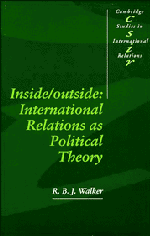Book contents
- Frontmatter
- Contents
- Preface
- 1 International relations as political theory
- 2 The Prince and ‘the pauper’
- 3 Ethics, modernity, community
- 4 History, structure, reification
- 5 Realism and change
- 6 The territorial state and the theme of Gulliver
- 7 On the spatio-temporal conditions of democratic practice
- 8 Sovereign identities and the politics of forgetting
- Notes
- Bibliography
- Index
1 - International relations as political theory
Published online by Cambridge University Press: 05 July 2011
- Frontmatter
- Contents
- Preface
- 1 International relations as political theory
- 2 The Prince and ‘the pauper’
- 3 Ethics, modernity, community
- 4 History, structure, reification
- 5 Realism and change
- 6 The territorial state and the theme of Gulliver
- 7 On the spatio-temporal conditions of democratic practice
- 8 Sovereign identities and the politics of forgetting
- Notes
- Bibliography
- Index
Summary
Outside and inside form a dialectic of division, the obvious geometry of which blinds us as soon as we bring it into play in metaphorical domains. It has the sharpness of the dialectics of yes and no, which decides everything. Unless one is careful, it is made into a basis of images that govern all thoughts of positive and negative. Logicians draw circles that overlap or exclude each other, and all their rules immediately become clear. Philosophers, when confronted with outside and inside, think in terms of being and non-being. Thus profound metaphysics is rooted in an implicit geometry which – whether we will or no – confers spatiality upon thought; if a metaphysician could not draw, what would he think? … The dialectics of here and there has been promoted to the rank of an absolutism according to which these unfortunate adverbs of place are endowed with unsupervised powers of ontological determination.
Gaston Bachelard, The Poetics of Spaceif it will kindly be considered that while it is in our interest as tormentors to remain where we are as victims our urge is to move on
Samuel Beckett, How It IsHistorical moments
Attempts to come to terms with the complexities, contradictions and opportunities of contemporary political life participate in a widespread sense of accelerations, disjunctions and uncertainties. The swift succession of events is already enough to induce vertigo, even among journalists, policy-advisors and other mediators of the moment.
- Type
- Chapter
- Information
- Inside/OutsideInternational Relations as Political Theory, pp. 1 - 25Publisher: Cambridge University PressPrint publication year: 1992

